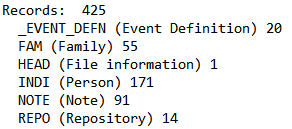|
The Log files lists information about the input file. You use the View Log File(s) command to view the Log file, and it is opened in your default text file viewer,
Behold does a lot of checking of the data for non-standard GEDCOM structures and for data problems that need your correction. The next page of this User Guide contains a complete list of the messages Behold can generate in the Log file.
 FilenameThe log file by default will be the GEDCOM file name with ".log" appended on the end. This makes it easy to identify the log file for any GEDCOM file and it will follow the GEDCOM file in a Windows Explorer alphabetical listing of a directory.
| |
 PreamblePreamble is a great word to mean the beginning of a file. The log file starts with "how", "who" and "when", and then goes into "what" and gives info about the "what".
| |
 Input Messages
Behold will list everything that it finds that is not quite right in the input file. Each message consists of:
-
The line number in the GEDCOM file followed by a colon. e.g. 246: -
The GEDCOM line in question, e.g. 2 MAP -
The message, preceeded by two asterisks to set it off, along with an indication as to how Behold will handle this. -
The number of occurrences so far of this message, in parenthesis preceeded by #, e.g.: (#1)
Many messages are simply incorrect GEDCOM syntax that Behold understands and interprets properly. These messages are included in the log file to let you know what is non-standard about the GEDCOM file, because other programs may not be able to read them. Because of this, you should be aware that you may lose this data if you read this into other programs.
Behold understands many exceptions and extensions to GEDCOM. Behold will read all of your data, and is unaffected by the problems in the file that are listed.
| |
 The Rest Of ItFollowing the messages is additional summary information:
-
A summary of all Messages, with the count of the number of each message in parenthesis , e.g.:  -
Summary of GEDCOM Tags with the text they'll display as,and the number of each. The tags are divided into 3 sections: Records, Pointers and Data Tags, e.g.:  ...  -
Processing Time, e.g.: 
| |
|
|